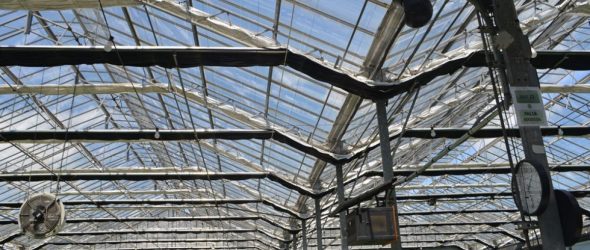 https://cannabisexaminers.com/wp-content/uploads/2019/12/120319-File-Carpinteria-Cannabis-Glass-House-Farms-Odor-Control-1-gm-1000_1200_800_s.jpg
https://cannabisexaminers.com/wp-content/uploads/2019/12/120319-File-Carpinteria-Cannabis-Glass-House-Farms-Odor-Control-1-gm-1000_1200_800_s.jpg
Air Pollution Control District review of Byers Scientific system found no toxic air contaminants in neutralizing products, spokeswoman says


Some Carpinteria cannabis farms use the Byers Scientific odor-control system, such as Glass House Farms shown here. The city of Carpinteria has asked the Air Pollution Control District to monitor and regulate the systems, which are required for Carpinteria Valley marijuana farms. (Giana Magnoli / Noozhawk file photo)
The concentration of cannabis farms in Carpinteria led the city to again ask the Santa Barbara County Air Pollution Control District to consider regulating the odor-control systems that greenhouses have installed and will be required to use during the permitting process.
There are about 34 sites in the Carpinteria Valley proposed for a farm or where marijuana is already being grown, according to the city.
Some two dozen farms already are operating, as legal nonconforming sites, and the city has been receiving complaints for years about cannabis odors — and the nuisance and health impacts of marijuana farms.
“However, the city also has received a number of complaints alleging that some of the reported ill health effects experienced by residents may not exclusively be the result of the nuisance odors from cannabis terpenes themselves, but from various odor-neutralizing or masking technologies (such as so-called “vapor phase systems”) being implemented by commercial cannabis cultivators in an attempt to comply with Santa Barbara County’s cannabis regulations,” the city said in a letter to APCD that was approved last week by the City Council.
“It is important that any chemical used for deodorizing systems not cause adverse impacts to the community,” the letter said.
Carpinteria city officials sent a previous letter to APCD in June, saying they did not think odor-control systems and other equipment should be exempt from regulation.
The APCD said health and safety codes that prohibit discharging air contaminants that cause a public nuisance, including odors, do not apply to some agricultural operations, but do affect manufacturing and smoking lounges, and other cannabis-related businesses.
“While the district lacks authority to take enforcement action to abate odors emanating from agricultural operations necessary for the growing and harvesting of cannabis, we do provide guidance on methodologies to reduce odor impacts,” the agency said in an April advisory.
There have been no changes since then related to the agency’s regulatory limitations on cannabis cultivation odors, APCD spokeswoman Lyz Hoffman said, adding that the agency had not received Carpinteria’s letter as of Monday.
“The final letter will be shared with APCD board members, and from there, we can discuss bringing this topic to them at a future APCD Board meeting,” she said.
As of June, 14 operating marijuana farms in the Carpinteria Valley used odor-control systems, and 12 specifically used Byers Scientific systems, which have PVC pipe wrapped around greenhouse buildings dispersing “neutralizing agents” through small holes 24/7.
Mark Byers of Byers Scientific has spoken to the Santa Barbara County Planning Commission about the technology, which was developed specifically for cannabis cultivation. The company also makes industrial odor-control systems for landfills and wastewater treatment plants, he said.
APCD did get confidential information about the chemicals used for the Byers odor-control system’s “neutralization product,” Hoffman said.
“Upon review of the confidential and redacted formulation information, APCD staff confirmed that none of the ingredients in ECOSORB CNB 100 are considered toxic air contaminants as identified by the state of California,” she said.
The Santa Barbara County Public Health Department said last week that it plans to create a way for physicians “to report suspected cases of allergic reactions to cannabis odors as part of our partnership with the local medical community and potential data collection efforts.”
“There is insufficient evidence in the medical literature at this time to determine if odor alone (even exclusive of pollen) can cause adverse physical reactions,” the Nov. 25 advisory says.
Public Health and other agencies have made Vaping-Associated Pulmonary Illness, also known as e-cigarette and vaping-related lung injury, a mandated reportable disease.
Cannabis-related illness was added as one as well, but it was removed in the latest advisory until there is clarification to separate it from vaping-related illnesses associated with cannabis, according to Public Health Department.
— Noozhawk managing editor Giana Magnoli can be reached at .(JavaScript must be enabled to view this email address). Follow Noozhawk on Twitter: @noozhawk, @NoozhawkNews and @NoozhawkBiz. Connect with Noozhawk on Facebook.



